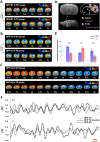Quasi-Periodic Patterns of Neural Activity improve Classification of Alzheimer's Disease in Mice
- PMID: 29968786
- PMCID: PMC6030071
- DOI: 10.1038/s41598-018-28237-9
Quasi-Periodic Patterns of Neural Activity improve Classification of Alzheimer's Disease in Mice
Erratum in
-
Author Correction: Quasi-Periodic Patterns of Neural Activity improve Classification of Alzheimer's Disease in Mice.Sci Rep. 2019 Nov 8;9(1):16732. doi: 10.1038/s41598-019-53432-7. Sci Rep. 2019. PMID: 31700115 Free PMC article.
Abstract
Resting state (rs)fMRI allows measurement of brain functional connectivity and has identified default mode (DMN) and task positive (TPN) network disruptions as promising biomarkers for Alzheimer's disease (AD). Quasi-periodic patterns (QPPs) of neural activity describe recurring spatiotemporal patterns that display DMN with TPN anti-correlation. We reasoned that QPPs could provide new insights into AD network dysfunction and improve disease diagnosis. We therefore used rsfMRI to investigate QPPs in old TG2576 mice, a model of amyloidosis, and age-matched controls. Multiple QPPs were determined and compared across groups. Using linear regression, we removed their contribution from the functional scans and assessed how they reflected functional connectivity. Lastly, we used elastic net regression to determine if QPPs improved disease classification. We present three prominent findings: (1) Compared to controls, TG2576 mice were marked by opposing neural dynamics in which DMN areas were anti-correlated and displayed diminished anti-correlation with the TPN. (2) QPPs reflected lowered DMN functional connectivity in TG2576 mice and revealed significantly decreased DMN-TPN anti-correlations. (3) QPP-derived measures significantly improved classification compared to conventional functional connectivity measures. Altogether, our findings provide insight into the neural dynamics of aberrant network connectivity in AD and indicate that QPPs might serve as a translational diagnostic tool.
Conflict of interest statement
The authors declare no competing interests.
Figures






Similar articles
-
Resting-State Co-activation Patterns as Promising Candidates for Prediction of Alzheimer's Disease in Aged Mice.Front Neural Circuits. 2021 Jan 22;14:612529. doi: 10.3389/fncir.2020.612529. eCollection 2020. Front Neural Circuits. 2021. PMID: 33551755 Free PMC article.
-
Dynamic resting state fMRI analysis in mice reveals a set of Quasi-Periodic Patterns and illustrates their relationship with the global signal.Neuroimage. 2018 Oct 15;180(Pt B):463-484. doi: 10.1016/j.neuroimage.2018.01.075. Epub 2018 Feb 15. Neuroimage. 2018. PMID: 29454935 Free PMC article.
-
Quasi-periodic patterns contribute to functional connectivity in the brain.Neuroimage. 2019 May 1;191:193-204. doi: 10.1016/j.neuroimage.2019.01.076. Epub 2019 Feb 10. Neuroimage. 2019. PMID: 30753928 Free PMC article.
-
Functional brain connectivity using fMRI in aging and Alzheimer's disease.Neuropsychol Rev. 2014 Mar;24(1):49-62. doi: 10.1007/s11065-014-9249-6. Epub 2014 Feb 23. Neuropsychol Rev. 2014. PMID: 24562737 Free PMC article. Review.
-
A survey on applications and analysis methods of functional magnetic resonance imaging for Alzheimer's disease.J Neurosci Methods. 2019 Apr 1;317:121-140. doi: 10.1016/j.jneumeth.2018.12.012. Epub 2018 Dec 26. J Neurosci Methods. 2019. PMID: 30593787 Review.
Cited by
-
15 Years MR-encephalography.MAGMA. 2021 Feb;34(1):85-108. doi: 10.1007/s10334-020-00891-z. Epub 2020 Oct 20. MAGMA. 2021. PMID: 33079327 Free PMC article. Review.
-
Functional network antagonism and consciousness.Netw Neurosci. 2022 Oct 1;6(4):998-1009. doi: 10.1162/netn_a_00244. eCollection 2022. Netw Neurosci. 2022. PMID: 38800457 Free PMC article.
-
Longitudinal investigation of changes in resting-state co-activation patterns and their predictive ability in the zQ175 DN mouse model of Huntington's disease.Sci Rep. 2023 Jun 23;13(1):10194. doi: 10.1038/s41598-023-36812-y. Sci Rep. 2023. PMID: 37353500 Free PMC article.
-
Neurovascular coupling: a review of spontaneous neocortical dynamics linking neuronal activity to hemodynamics and what we have learned from the rodent brain.J Neurophysiol. 2025 Feb 1;133(2):644-660. doi: 10.1152/jn.00418.2024. Epub 2025 Jan 17. J Neurophysiol. 2025. PMID: 39819035 Free PMC article. Review.
-
Long-term ovarian hormone deprivation alters functional connectivity, brain neurochemical profile and white matter integrity in the Tg2576 amyloid mouse model of Alzheimer's disease.Neurobiol Aging. 2021 Jun;102:139-150. doi: 10.1016/j.neurobiolaging.2021.02.011. Epub 2021 Feb 22. Neurobiol Aging. 2021. PMID: 33765427 Free PMC article.
References
-
- Barage SH, Sonawane KD. Amyloid cascade hypothesis: Pathogenesis and therapeutic strategies in Alzheimer’s disease. Neuropeptides. 2015;52:1–18. - PubMed
-
- Hardy JA, Higgins GA. Alzheimer’s disease: the amyloid cascade hypothesis. Science (80-.) 1992;256:184–185. - PubMed
-
- Kumar A, Ekavali AS. A review on Alzheimer’s disease pathophysiology and its management: an update. Pharmacol. Reports. 2015;67:195–203. - PubMed
-
- Biswal B, Yetkin F, Haughton V, Hyde J. Functional connectivity in the motor cortex of resting human brain using. Magn Reson Med. 1995;34:537–541. - PubMed
Publication types
MeSH terms
Grants and funding
LinkOut - more resources
Full Text Sources
Other Literature Sources
Medical
Molecular Biology Databases
Research Materials
Miscellaneous

